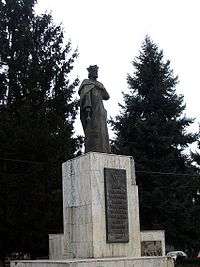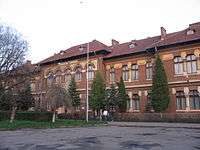Roman, Romania
| Roman | ||
|---|---|---|
| Municipality | ||
|
History Museum in Roman (Nevruzzi House) | ||
| ||
 Roman Location of Roman, Romania | ||
| Coordinates: 46°55′48″N 26°55′48″E / 46.93000°N 26.93000°ECoordinates: 46°55′48″N 26°55′48″E / 46.93000°N 26.93000°E | ||
| Country |
| |
| County | Neamț County | |
| Status | Municipality | |
| Government | ||
| • Mayor | Dan Laurenţiu Leoreanu (Democratic Liberal Party) | |
| Area | ||
| • Total | 30.08 km2 (11.61 sq mi) | |
| Population (2011) | ||
| • Total | 50,713 | |
| • Density | 1,685/km2 (4,360/sq mi) | |
| Demonym(s) | romașcan, romașcancă (ro) | |
| Time zone | EET (UTC+2) | |
| • Summer (DST) | EEST (UTC+3) | |
| Website | http://www.primariaroman.ro/ | |
Roman (Romanian pronunciation: [ˈroman]; German: Romesmark, Hungarian: Románvásár) is a city with the title of municipality located in the central part of Moldavia, a traditional region of Romania. It is located 46 km east of Piatra Neamț, in Neamț County at the confluence of the Siret and Moldova rivers.
Its name was taken from Moldavian Voivode Roman I of Moldavia, believed to be its founder. Roman's first son was Alexandru cel Bun. From here prince Roman has realized the centralization of Moldavia, Roman city being capital of Lower Country of Moldavia (Romanian: Tara de Jos) .
History

The earliest mention of the city is in the Novgorod Chronicle (dated between 1387 and 1392). Five years later, the name appeared on a donation deed. The city is mentioned in a Moldavian document, signed by Moldavia's Voivode Roman I, on March 30. The document is one of the first of documents of the then-young state of Moldavia, being the first which holds a fully legible version of the Moldavia seal, bearing the aurochs, the moon, the star, and the flower, still in use on Coat of Arms of Moldova.
Roman became a diocesan see in September 14, 1408, when Alexandru cel Bun established an orthodox bishopric in the city. The representatives of the Catholic population of Roman, shepherded by the Bishop of Baia, attended the Council of Constance in 1412.
Later on in the late 15th century, Ştefan cel Mare build a new stone fortress on the left bank of the Siret river, to replace the old earthen one. Several documents from 1458, 1465 and 1488 during Ştefan's reign mention the Cathedral of Saint Paraskeva (Paraschiva) in Roman. In 1467, the fortress resisted the siege of the Hungarian army under King Matthias Corvinus, before the battle of Baia. In 1476, an Ottoman army, led by Mohamed II, besieged the new fortress again, with the Moldavians retreating after the Battle of Valea Albă.
Petru Rareş ordered the construction of a new episcopal see on the same spot in 1542. The old fortress was apparently destroyed by Dumitraşcu Cantacuzino, following Ottoman command, together with all other Moldavian fortresses. One of the last mentions of it dates back to 1561–1563 during the reign of Ioan Iacob Heraclid. The catholic community had its rights restored around the same time, in 1562, as Ioan Belusiuş, an agent of the Holy Roman Emperor Ferdinand I, wrote his master from Roman, after the severe limitations under Alexandru Lăpuşneanu. In 1623, the catholic community was described by the Franciscan missionary Andreas Bogoslavici in a letter sent to Rome, as Hungarian that understood and used Romanian. The Catholics appear to have a church dedicated to Saint Peter.
In 1569, Ruxandra Lăpuşneanu built an orthodox church dedicated to the Holy Virgin (Precista Mare) on the same spot the eponym church is placed today. In 1595, the church Sfinţii Voievozi is built. The current Armenian Orthodox Church was built in 1610.
Some demographic data from 1641, recorded by the Vicar of Sofia, who was passing through Roman, shows there were apparently 1,500 Eastern Orthodox, 450 Armenian Orthodox and 30 Hungarian Catholics.
A major personality of the city was orthodox bishop Dosoftei who translated the Psalter into Romanian in 1665–1671. In December 1691, Miron Costin, one of the first historians and writers in Romanian, was decapitated here on the orders of Prince Constantin Cantemir (Dimitrie Cantemir's father). Costin was in custody, being carried from Bărboşi to Iaşi, where he hoped to prove his innocence; a few days earlier, the chronicler's brother had been killed in Iaşi, being believed to have attempted to obtain the throne for himself. The statue marking the spot is now obscured by a blue glass pyramid near the Roman Hotel.
The first hospital in Roman was built in 1798 on the place where the Municipal Hospital Precista Mare is located today. Talmud Torah, one of the first Jewish schools in Principality of Moldova, was inaugurated in 1817, an important event in itself as Moldova did not grant citizenship to Jews.


Roman became a railway hub in the 19th century, when the second railway in Romania was opened in December 1869, from Roman to Suceava (Iţcani). One year later, on December 27, 1870, The Bucharest-Galaţi-Roman railway was also opened, linking Roman to the capital via Mărășești, Tecuci, Galaţi, Brăila and Buzău. Right after the inauguration, this railway was closed due to technical problems, but it was reestablished on September 13, 1872. At the same time, after a reluctant government gave its long-waited approval, the first high school of the city, Roman-Vodă, was opened on September 30 in the building that is still in use today as that of School No. 1.
In the communist era, the city lost the county capital status, being included, in 1950-52 and 1956-68, in Bacău Region, in 1952-56 in Iași Region, and then, in 1968, in Neamț County. It also became the target of industrialization: in 1957, the steel tubes factory started production. Roman became an important industrial center in Romania.
After the fall of communism, most of the heavy industry, relying strongly on state subsidies, went bankrupt and Roman's economy struggled. The steel tubes factory was privatized, and it is now owned by the Mittal Steel Company N.V., and the economy started to recover.
Geography and demographics
| Historical population | ||
|---|---|---|
| Year | Pop. | ±% |
| 1912 | 18,128 | — |
| 1930 | 28,823 | +59.0% |
| 1948 | 23,701 | −17.8% |
| 1956 | 27,948 | +17.9% |
| 1966 | 39,012 | +39.6% |
| 1977 | 51,132 | +31.1% |
| 1992 | 80,328 | +57.1% |
| 2002 | 69,483 | −13.5% |
| 2011 | 50,713 | −27.0% |
| Source: Census data | ||
Roman is located in north-eastern Romania, in Neamț County, in the historic region of Moldavia, at the mouth of the Moldova River, a tributary to the Siret. The nearest large city is Bacău, 40 km away on DN2 and on the Suceava-Bucharest railway; Piatra Neamț, the county capital, is 50 km away and Iași, the historic capital of Moldavia, is 80 km away.
Natives
- Ion S. Antoniu
- Filip Brunea-Fox
- Sergiu Celibidache
- Gheorghe Flondor
- Ion Ionescu de la Brad
- Dumitru Irimia
- Mihail Jora
- Andreea Marin
- George Radu Melidon
- Simona Spiridon
- Tereza Pîslaru
- Paul Riegler
- Nae Roman
International relations
Twin towns – Sister cities
Roman is twinned with:
External links
| Wikimedia Commons has media related to Roman, Romania. |
- ROMAN-Romania.ro - website
- (Romanian) Ziarul de Roman - Local newspaper
- History of Roman Jews
- Melidonium magazine


